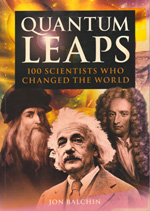|
Quantum Leaps - 100 Scientists who changed the World
Jon Balchin
 2004 Arcturus Publishing
2004 Arcturus Publishing
ISBN 978-1-84193-156-2
208 pages. Soft Cover.
One illustration per person.
Purchasing Details.
Amazon
My Comments on This Book
This book has 2 pages on the 100 most important people in science.
The Wright brothers were technologists rather than scientists but it is an American book.
Each illustration of the person is enclosed by a nuclear atom.
It cannot be recomended as a brief introduction to Rutherford because of the large number of errors.
Errors Noted.
p154 Rutherford didn't establish a new (radioactivity) branch of physics in 1902. This was done by Becquerel in 1896.
p154 in 1919 Rutherford first split the atom using naturally occurring alpha particles from radioactive source, not developed a proton accelerator.
p154 Rutherford won a scholarship which he elected to take at Cambridge University.
p154 He discovered, and named, alpha and beta particles at Cambridge, not at McGill.
p155 Prior to Rutherford's discovery in 1903, alphas were regarded as undeviable in a magnetic field.
p155 The original 1908 device for detecting single alpha particles, wanted and devised by Rutherford with Geiger's help,
was called the Rutherford-Geiger tube. Today's Geiger-Muller tube is very much the R-G tube.
p155 Small angle alpha scattering was observed by Rutherford when still at McGill. On moving to Manchester in 1907 he put Geiger onto accurately
measuring this (about 2 degrees). In 1909 he asked Marsden to determine if alpha particles were scattered off a metal block.
p155 Large angle alpha scattering was observed off all metals, from lead to aluminium and even off thin gold foils such as Geiger was using.
p155 Weight of the nucleus. Better to use mass.
p155 1919 was the year of publication of Rutherford's paper announcing transmutation from nitrogen to hydrogen.
However it was done earlier and not published until after the war ended and as he was moving to Cambridge.
He did most of the work at Manchester as the young men were at the war.
Contents
There are two pages and one illustration of each person.
Rutherford is p154-5.
Reviews
Not known at this stage.
back to top
|

